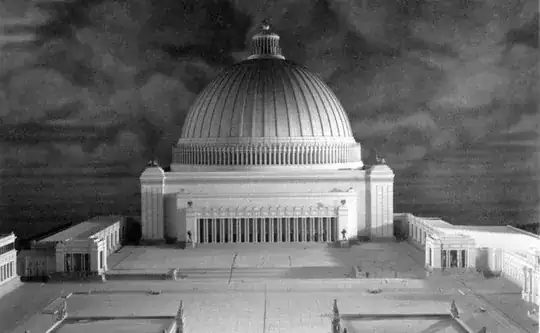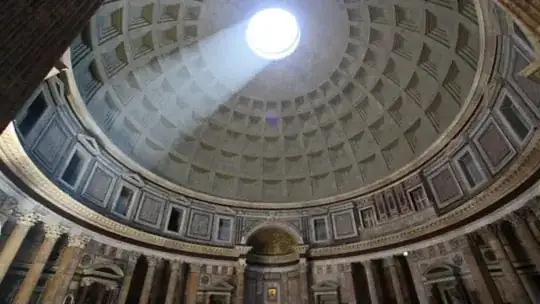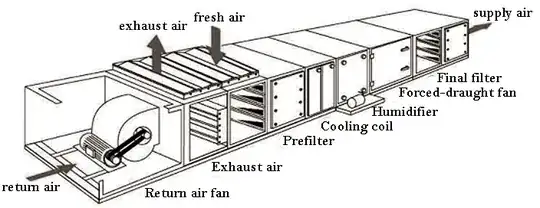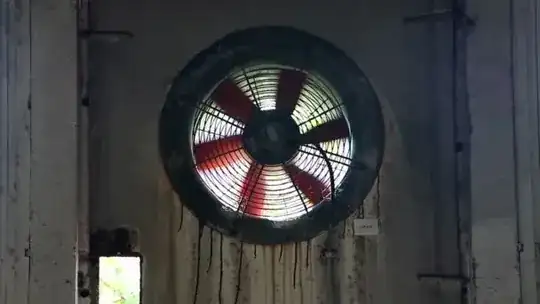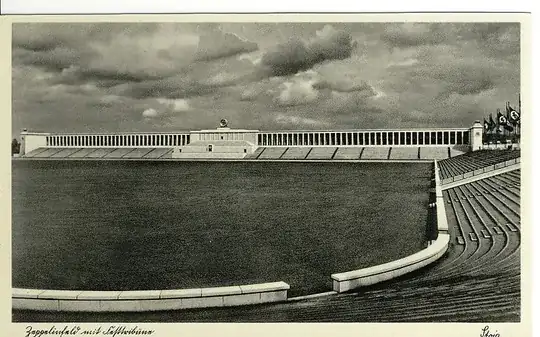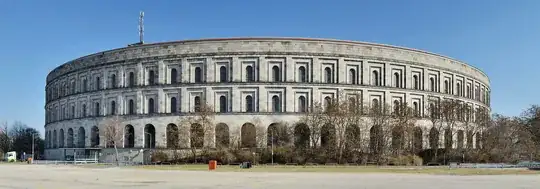Maybe you might actually want rain inside the Volkshalle. Should interior rain be considered a bug or a feature?
PART ONE: Interior Rain in the People's Hall?
Other large interior spaces have interior weather and interior rain.
The Vehicle Assembly Building has internal weather:
Within the VAB, that warm moist air rises, and rises, and rises. As it does, the moisture condenses. By the time it gets to the top of the building condensation forms on surfaces and a mist is sometimes visible. That condensation then falls down, like rain.
https://www.quora.com/What-is-the-scientific-explanation-of-the-Nasa-Vehicle-Assembly-Building-having-its-own-rainclouds-weather1
The building has at least 40 MW of air conditioning equipment, including 125 ventilators2 on the roof supported by four large air handlers (four cylindrical structures west of the building) to keep moisture under control. Air in the building can be completely replaced every hour. The interior volume of the building is so vast that it has its own weather, including "rain clouds form[ing] below the ceiling on very humid days",[11] which the moisture reduction systems are designed to minimize.
At 3,664,883 cubic meters (129,428,000 cubic feet) it is one of the largest buildings in the world by volume.
https://en.wikipedia.org/wiki/Vehicle_Assembly_Building2
The VAB is merely the seventh largest building by volume in Wikipedia's list of largest buildings.
https://en.wikipedia.org/wiki/List_of_largest_buildings3
The largest is:
The Boeing Everett Factory, in Everett, Washington, is an airplane assembly building owned by Boeing. Located on the north-east corner of Paine Field, it is the largest building in the world by volume at 13,385,378 m3 (472,370,319 cu ft) and covers 399,480 m2 (98.7 acres; 39.948 hectares; 0.399 square kilometres).
https://en.wikipedia.org/wiki/Boeing_Everett_Factory4
The Boeing factory is so big it that is rains in the factory? True.
This factory is so massive that when the factory was first built, clouds, the product of accumulated warm air and moisture, actually formed near the ceiling. However, the “weather” cleared when a state-of-the-art air circulation system was installed.
https://blogs.mentor.com/jvandomelen/blog/2010/04/15/the-biggest-building-in-the-world-10-boeing-everett-factory-myths-true-or-false/5
Rumor #2 It rains in the factory
The factory is such a massive facility, that could fit 75 American football fields inside. Due to its size, there is a common notion, that it rains in the facility. There is some truth to the myth. In the late 1960s, aircraft manufacturing processes produced warm air and small clouds formed near the ceiling. As one can imagine, water and mechanics are not birds of a feather, therefore, the Boeing Company installed a state-of-the-art air circulation system to avoid the formation of the clouds.
https://www.aerotime.aero/aerotime.team/12860-the-stories-about-everett-factory-myths-vs-truth6
The 17th and smallest building in the list of the largest buildings by volume is Hanger One, Mountain View, California. It is listed as having an interior volume of one million cubic meters or thirty five million cubic feet.
https://en.wikipedia.org/wiki/List_of_largest_buildings3
The hangar's interior is so large that fog sometimes forms near the ceiling.2
https://en.wikipedia.org/wiki/Hangar_One_(Mountain_View,_California)7
So it seems that structures as "small" as 1,000,000 cubic meters or 35,000,000 cubic feet can have interior weather with mists, fog, clouds, and rain happening inside.
I don't know the interior volume of the Volkshalle would have been. Wikipedia says:
...The dome of the Volkshalle was to rise from a massive granite podium 315 by 315 metres (1,033 ft × 1,033 ft) and 74 metres (243 ft) high, to a total inclusive height of 290 metres (950 ft). The diameter of the dome, 250 metres (820 ft),...
https://en.wikipedia.org/wiki/Volkshalle8
Assuming that the room under the dome would have an interior diameter of 250 meters (820 feet) and a total height of 290 meters (950 feet), it could be calculated as a cylinder with those dimensions. Thus it should have a total volume of about 14,200,000 cubic meters, or about 500,000,000 cubic feet. If those figures are divided by about two to allow for the shape of the dome, the interior of the main room would be about 7,000,000 cubic meters or about 250,000,000 cubic feet.
So that would make the main room about 7 times the size of Hanger One, almost twice the size of the Vehicle Assembly Building, and a little more than half the size of the Boeing Everett Factory.
Thus it seems reasonable to assume that the main room in the Volkshalle would probably have interior weather, mists, fogs, clouds, and rains, and that some sort of climate control machinery would be needed to prevent or control such indoor weather.
So how should the architects and planners result to the realisation that the Volkshalle would have interior weather?
PART TWO: Throne rooms of Galactic Emperors
I remember in a science fiction novel, Mission to the Heart Stars (1965) by James Blish, the heroes travel to the center of the galaxy, to the capital of the Hegemony of Mallis. When they meet the Hegemon, sort of a galactic emperor, the throne room is described as a very vast and awe inspiring hall.
And then Blish sort of spoiled the effect of the throne room by having one of the characters sort of exaggerate and imagine that the throne room could be vast enough to have its own indoor weather and rain. I couldn't believe that a brilliant writer like Blish could be so stupid. I knew that the Vehicle Assembly Building is large enough to have internal weather and rain. So by having a character merely get carried away by their imagination and exaggeratedly wonder if the room was big enough to have internal weather, Blish was suggesting that a galactic emperor might possibly have had such a modest and humble throne hall that it was actually even tinier than the Vehicle Assembly Building!
Well, I for one, think foul scorn that any science fiction writer could ever imagine any self respecting galactic emperor would ever have such a tiny throne room that it was too small to have its own weather system.
I would imagine that even the small, private, audience chamber of a galactic emperor, a tiny fraction of the size of their medium audience hall, which in turn would be a tiny fraction of the size of their large audience hall, would be many times large enough to have its internal weather.
But how would a galactic emperor's architects handle the problem of it raining inside the throne room?
PART THREE: An Example from Earth's history
And I ask what problem?
Khosrow or Chosroes II, King of Kings of Iran and of Non Iran (reigned 590 to 628), built a fabulous and legendary building - a temple, palace, or public building, or maybe some combination - that was destroyed by the Roman army near the end of the terrible Roman-Persian war of 602-628.
As I remember, there was a hall with a column, and a statue of a god or of Khosrow on the top of the column, and there was a dome above the room, and the inside of the dome was decorated to resemble the heavens. And the dome could be made to revolve around the statue, like the heavens appear to revolve around the Earth, perhaps inspired by stories of the rotating room in Nero's Golden House. And as the heavenly dome revolved, it made a noise like thunder, and sprinklers could be used to make it appear to rain inside the hall.
So this hall suggested that the god, or Khosrow, was the master of the universe and could control the weather.
And I can imagine a galactic emperor might have gigantic throne halls of similar design but scaled up many times the size of that room, and use climate control systems to prevent rain when it wasn't wanted and cause rain when it was wanted, and systems to make artificial thunder and lightening.
A galactic emperor would know that their subjects were too scientifically educated to be fooled into thinking they were divine by such effects, but the subjects would probably appreciate the entertainment provided by such effects. And the galactic emperor would probably know that many previous rulers on various planets used such designs even when their technology was much more primitive than the galactic emperor's, so if they do not use a super sized version of such throne rooms they will be failing to keep up with rulers who had less than one subject for each planet that the galactic emperor rules.
I would certainly feel humiliated if I described a place and/or throne hall for a galactic emperor and then discovered that it was in any way inferior in size, aesthetics, or technology, to a palace and/or throne a hall of any imperator, or basileus, or shahanshah, or padishah, or huangdi, or other ruler, in Earth's history.
PART FOUR: What Would Hitler's Architects Do About the Rain?
And again I ask: "Why stop the rain?"
If the Volkshalle was so large that it might sometimes naturally rain in there, it would be logical to install systems to control the internal climate and weather, to keep it from raining when it was not wanted. But it also seems logical to me to sometimes use those climate control systems to make it rain when rain was wanted. And thus perhaps make artificial rain, thunder, and lightening to put emphasis on the right moments of Hitler's speeches.
But such an artificial weather system might seem too good for Nazis and Hitler. A writer might not want to depict them enjoying such features in their great hall.
But on the other hand, a story where Hitler is accidentally electrocuted by the artificial lightening would be kind of funny.
But on a third hand, you might write a scene where someone has designed such a system for the hall but in a meeting Hitler rejects the idea of installing it, thus revealing how unimaginative he was.
But on a fourth hand, considering all the horror and suffering, death and destruction, from Nazi victories that would be required for the Volkshalle to be built, you might want at least a little bit of something good to come from all that evil, and thus want the Volkshalle to be as wonderful as possible.
And on a fifth hand, maybe the system would be used only when giving tours of the Volkshalle to hordes of school kids with raincoats and umbrellas. They could turn off the rain discouraging system and turn on the rain encouraging system and the kids could watch clouds form and rain start. And they could turn on the artificial thunder and lightening to make it more impressive for the kids.
On a sixth hand, maybe the Nazis only install the rain discouraging and the rain encouraging parts of the system, without the artificial thunder and lightening.
The Nazis could keep it from raining when they don't want it to, but when a meeting is ending or when the building is closing for the night, they could turn on the rain encouraging system so the rain would encourage people to leave.
And if there was a fire in the Volkshalle they could use the rain encouraging system like a sprinkler system to fight the fire.
And maybe when they wash down the interior of the Volkshalle they would bring in firetrucks with super powerful hoses to spray the floor and walls with detergent and then turn on the rain encouraging system to make it rain inside and rinse away the detergent down grates in the floor (The Pantheon in Rome has grates in the floor for rainwater).
